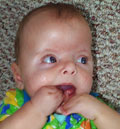 |
 |
|
Apert's & the Enigma of Chromosome No.10 Andrew's Receded Midface Advanced
Craniofacial Surgery: Tennessee Craniofacial Center Erlanger Health System Erlanger on Apert: Nat'l Org. for Rare Disorders: Apert's & Related Conditions Craniofacial Work at Columbia: Apert Syndrome: Faces-Cranio Disorders Clinical Variability in Patients: |
A CONGENITAL DEFECT FOR ONE IN 200,000 ... BECOME SOLDIERS WHO ARE ONE IN A MILLION What Is Apert Syndrome? BY JPAPA Although
the first appearance of Apert Syndrome in a family is as rare as
one birth in 200,000 occurences, it is the result of a spontaneous
mutation at conception.
Yes, Apert syndrome is a result of genetic mutation.* When you have Apert syndrome, you have a 1 in 2 (50%) chance of passing this condition on to your child. This is because each of us gets 1/2 of our genetic makeup from each parent. However, Apert is not a recessive trait, which means that the UNaffected child of a parent with Apert syndrome is no more likely to have a child with Apert than any other person; also, if you have a child with Apert and you do NOT have Apert, YOU are no more likely to have another child with Apert than anyone else in the population. Studies have shown that Apert occurs more often in children of older fathers. Recently studies were conducted at Oxford University and they managed to identify the actual genetic change which occurs in Apert. The following is a quote from a letter sent to the test families by Oxford. "A total of 86 children and adults affected with Apert syndrome have been seen. From the blood samples which have been donated for research, we have identified the genetic change that causes the condition. The change is in a gene on chromosome number 10 called 'Fibroblast Growth Factor Receptor 2' (FGFR2 for short). We all have two copies of this gene (one from mother, one from father), which is composed of a string of about 2000 of the chemical building blocks that make up the genetic material called DNA. When Apert syndrome occurs, just one particular building block in one of these two gene copies has been exchanged for another. The other gene copy is entirely normal. This one tiny change in the FGFR2 gene results in the physical features of Apert Syndrome." A medical table describing the genetic characteristics of Apert Syndrome can be found at the National Institute of Health's NIDCR Dental, Oral and Craniofacial Gene site. *From data in an
article entitled |
|
|
APERT SYNDROME STORIES/SUPPORT Teeter's Page. Major site for Apert links and family-managed Apert ListServ. Apert Chat. Supplement to the Apert ListServ. An Excite community. Apert Support Group at Harvard. Andrea's Page. Personal account from Andrea Gartner, a college student with Apert Syndrome. Amy's Page. Personal account from Amy Esler, a girl with Apert Syndrome. Apert ListServ. An archive of ListServ postings on Apert Syndrome. ApertInfo: Story of Matthew Romero, in conjunction with Children's Hospital of Boston. Thrive Online: A med library article on Apert Syndrome. OTHER RESOURCES (These Links Will Open In New Browser Windows) Swedish Apert Syndrome Informat Medical College of Wisconsin: Apert Overview CCAKids PDF on Apert Syndrome FamilyVillage on Apert's Craniofacial Anomalies:Tooth Formation and Eruption in Patients WideSmiles: Apert Cleft Links |
||
| eXalTerNet | TOP OF PAGE |
